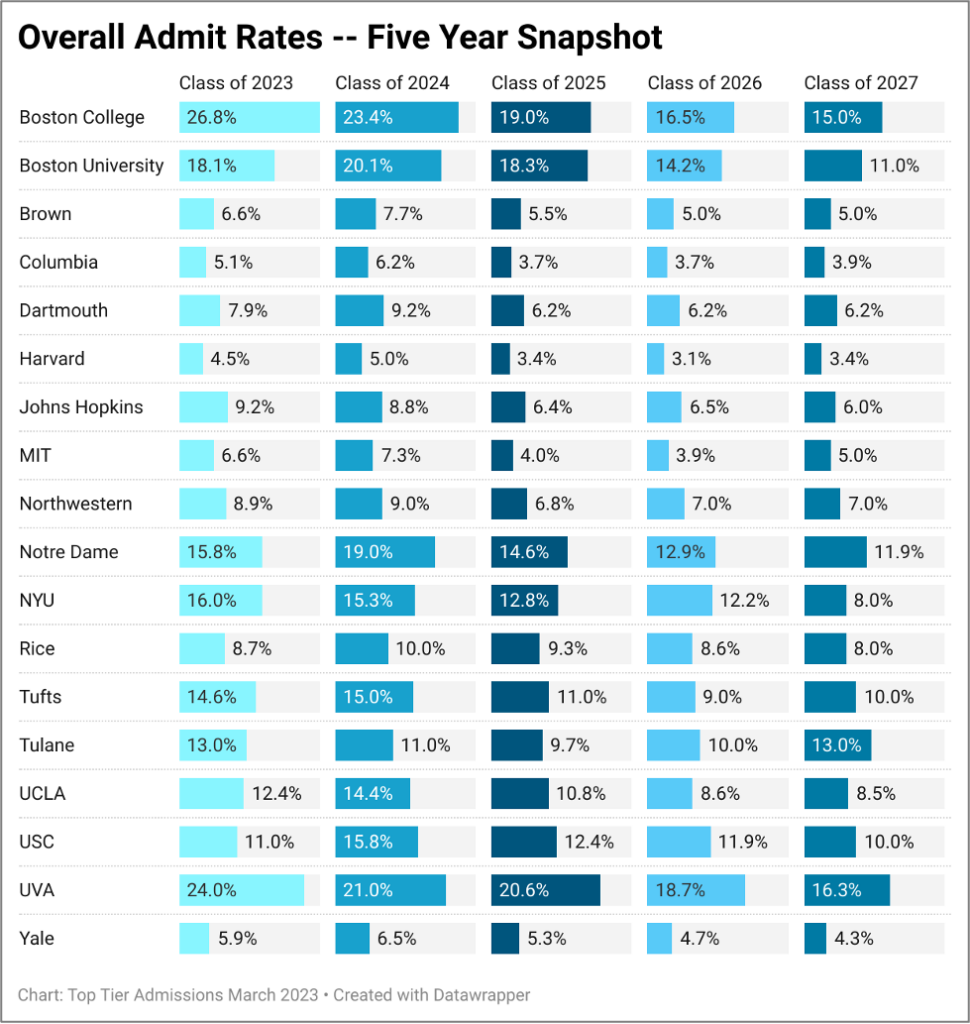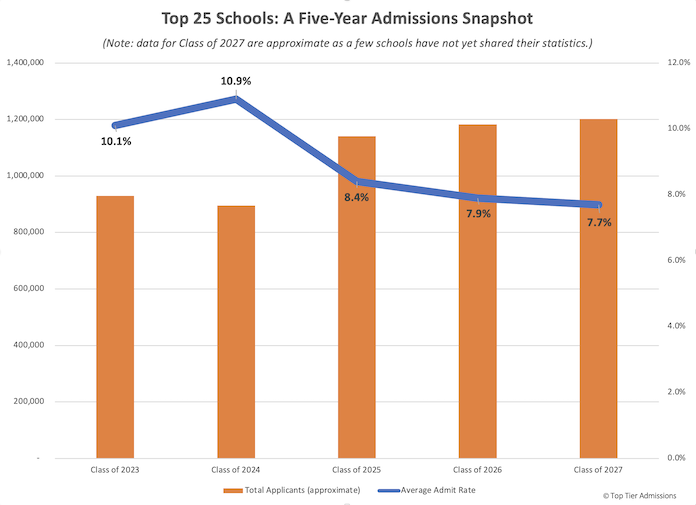With its bracket-busting buzzer beaters and Cinderella stories, the NCAA’s annual basketball tournament has plenty of madness to go around this March. So, too, does the world of selective college admissions. This month, many university press releases breathlessly proclaim record-breaking volume and lowest admit rates in their history.
WHAT’S BEHIND THE MADDENINGLY LOW ADMIT RATES?

Here’s just a sampling of what we’ve seen so far:
- Colby College admitted just 6% of applicants to the Class of 2027, down one point from last year’s record-low admit rate. The number of applications submitted grew by 5% and interestingly, Colby chose to admit 100 fewer students, likely in reaction to a larger than expected Class of 2026.
- NYU, as noted in their press release, has been smashing records for the last 16 years. NYU received close to 120,000 applications to the Class of 2027, a 13% increase over last year’s record-breaking pool, including nearly 22,000 Early Decision applications, an increase of 14 percent from last year. This is the 16th year in a row of record-setting numbers of applications to NYU. The result? NYU’s admit rate dropped to a record-low 8% overall, down from 12.2% for the Class of 2026.
- Notre Dame, drawing from a pool of 28,351 applicants, hit an 11.9% acceptance rate, “the lowest in Notre Dame history” according to vice president for undergraduate enrollment Micki Kidder. While the regular decision cycle saw a 2% increase from the previous year, the REA cohort saw a 25 percent growth.
- Tufts, which admitted 9.5% of applicants this year, notes that for the second year in a row, applications for undergraduate admission topped 34,000. “Tufts is also the first-choice school for more students than ever, as reflected in a 6% increase in Early Decision applications over last year, and a 37% increase over three years ago.”
- Yale’s applicant pool grew by 4.4% to 52,250 students, the largest pool in the university’s history, and its admit rate dropped to 4.35%, the lowest in its history. The number of applicants for the Class of 2027 is up by nearly 50 percent compared to the pool of students who applied to the Class of 2024. Yale’s decision to adopt and extend its test-optional policy in response to the COVID-19 pandemic was cited by Dean of Admissions Jeremiah Quinlan as a significant contributing factor to this surge in volume.
- UConn received more than 48,000 applications for its Class of 2027 for Storrs applicants, a significant jump from last year’s approximately 43,000. This trend indicates the University’s growing appeal as each year’s tally exceeds the last.
- USC, which introduced an early action option for the first time this year, announced the breaking news on Twitter that it had received 81,000 application and saw its overall application volume explode by over 17 percent to record high levels.
- UVA’s release notes that in this historic application cycle, 56,439 people had applied to the University in yet another record-breaking year (Virginians accounted for 27% of applicants). That’s compared to 50,962 applications last year and 48,011 in 2021.
UNPACKING THE NUMBERS
Let’s unpack the factors that are driving up application volume and driving down admit rates. We know that the pandemic-era changes to testing policies were the catalyst for dramatic pool growth, most notably with applicants to the Class of 2025. Colleges and universities have always invested resources in building their applicant pools, but now, that work has gone into overdrive. Today, schools devote significant resources to recruiting prospective students—everything from tour guides to TikTok influencers, virtual events to admissions officers traveling the world, and outside firms that use data-driven precision to target students and flood their inboxes with emails. To be fair, some of this pool-building work has been important outreach to encourage students from historically underrepresented backgrounds to consider the college or university, but the drive for ever greater application numbers seems more driven by institutional bragging rights than what’s in the best interests of students (or overworked admissions officers).
THE ROLE OF NON-BINDING EARLY ACTION
Colleges and universities looking to build their applicant pool use multiple strategies to convert prospective students into applicants. The use of non-binding early action programs is a case in point. This year, USC added non-binding EA to its admissions options which drew over 40,000 applicants and as noted above, led to a 17 percent increase in overall applications. Northeastern, which requires no admissions supplement and has a non-binding EA option, has seen its applications swell by 50 percent to over 96,000 in the space of a few years and its admit rate plunged from about 18 percent to 6.7 percent.
UVA and the University of Michigan, top public flagship universities, have also seen more and more out-of-state students apply using the non-binding EA program, driving up overall application volume. This year, UVA received a record 56,439 applicants (10 percent more than last year) because of the surge in EA applications from out of state students. Understandably as a state school, UVA has a mandate to serve residents of Virginia, but the university uses its non-binding EA program to grow its applicant pool. Case in point: 75 percent of UVA’s EA applicants are out-of-state students, but those students make up only 56 percent of those admitted in EA.
OVERCROWDING AND PREDICTING YIELD
Overcrowding on campus—usually the result of unexpected bumps in yield in the prior admissions cycle—can lead to fewer offers of admission this year as colleges look to relieve pressure on overcrowded dorms, dining halls, and other facilities. Contributing to Colby’s record-low admit rate this year was the decision to accept 100 fewer students than last year. MIT saw significantly increased yield with the Class of 2026 and so this year, the 1,259 students offered admission to the Class of 2027 represented the fewest number of students ever admitted to MIT.
Finally, as we’ve reported on in the past, the use of binding early decision programs allows colleges and universities to lock in a significant proportion of first year students – typically 40-50 percent (or more) of their incoming class in this first round. Because the early decision process requires a commitment to attend, these applicant pools are typically small and self-selecting. Even though many hooked students apply in the ED round (recruited athletes and legacies, especially), there’s no denying that well-qualified students applying in the early round have significantly better odds of admission. Colleges want to maximize their yield—the percentage of admitted students who enroll—because higher yields make them look more desirable, in turn allowing them to attract stronger applicants. Binding early decision plans also allow colleges to accurately predict their yield, crucial for managing class sizes, dorm room allocations, and institutional revenue.

Application Boot Camp®
Need strategic guidance from start to finish? Try Application Boot Camp®.
NOT EVERYONE IS SMASHING RECORDS
Amherst reported a 14.2 percent drop in application numbers this year from the past two years’ record highs. This year, 9 percent of the 12,700 applicants were offered admission, a 2 percent increase in admit rate from last year’s record-low 7 percent.
Columbia, which saw its US News and World Report ranking tumble this year from No. 2 to No. 18, the result of inaccurate data submitted and the controversy that ensued, saw its early decision application volume drop by 9 percent and the overall application volume drop by over 5 percent. It’s hard to not link the drop in USNWR ranking and bad press to ED and overall application volume this year.
Perhaps small consolation to the thousands of Harvard hopefuls who were not offered admission, the university saw its application volume drop by 7 percent and its admit rate tick up slightly to 3.4 percent this year.
MIT, which reinstated its standardized testing requirement this year, received 26,914 applications for admission, a 20 percent decrease over last year’s record volume. MIT’s release notes that significantly increased yield the past few years meant that, even with the decrease in volume, the 1,219 students offered admission to the Class of 2027 was the fewest students ever admitted. With its 4.7 percent admit rate, MIT is still uber-selective and highly sought-after.
After peaking last year at just about 150,000 applications, UCLA saw its numbers cool slightly for the Class of 2027 to roughly 146,000 submissions (a 2.6 percent decrease). Similarly, after growing by 14 percent last year to 128,192, the number of students applying to UC Berkeley for the Class of 2027 dropped by 2.3 percent. In both cases, the declines were primarily out of state students and international students.
Although Williams had its largest early decision applicant pool in its history (943 applicants) and its lowest ED acceptance rate on record (dropping by 6 percentage points to 27 percent), regular decision applications decreased by almost 25 percent since last year. Helping keep its overall admit rate below 10 percent (9.8 percent to be exact) was its decision to decrease the total number of students offered admission and aim for a slightly smaller first year class.
SINK YOUR ADMISSIONS BUZZER-BEATER
With record-breaking application volume and ever lower admit rates, it might be tempting to assume there’s nothing you can do to improve your odds of admission. After all, with 120,000 applications, does a school like NYU even bother to truly read every application?
Our students’ admissions results show that there’s plenty you can – and should do – to make your application compelling and distinctive.
- Class of 2028 Admissions: A Cycle Marked by New Challenges - May 13, 2024
- Global Campuses, Dual Degree and Joint Degree Programs: What You Need to Know - April 29, 2024
- College Admissions: The Year in Review - December 27, 2023


